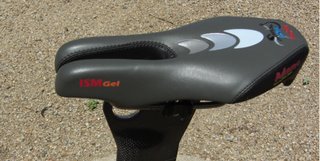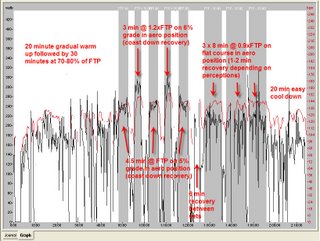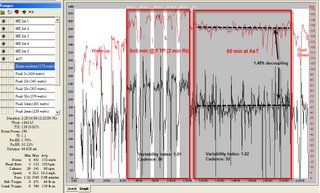 John Cobb has done it again. He’s always coming up with stuff that helps me ride faster, but now he’s making me more comfortable, too.
John Cobb has done it again. He’s always coming up with stuff that helps me ride faster, but now he’s making me more comfortable, too.
I’m getting back into time trialing this year. I used to do these quite often. One of the biggest obstacles to racing well, I found, was that my butt got so sore in the aero position that I had to wear two pair of cycling shorts for the extra padding. As the hips roll forward into an aero position body weight shifts toward the soft tissues. The more aggressive the position, the more discomfort I experienced. For a man to be even moderately comfortable (which means significantly uncomfortable) he must adjust his equipment to one side or the other of the nose of the saddle. There is simply no way to eliminate the discomfort of that damned saddle nose sticking out between the thighs. That is until I came a cross the Adamo saddle that John helped to design.
But getting back to my training… I found I wasn’t looking forward to my once or twice weekly aero-position rides on my Cervelo P3c because of the discomfort. So I decided to shop around for something that would feel better. I had recently seen John’s Adamo saddle at the Blackwell Research booth at the SICI conference in Denver. So I decided to give it a try.
The Adamo certainly looks different. It doesn’t have the long, sleek look of my Specialized Toupe. It’s a little goofy looking with a short length and a pair of stubby rails sticking out in front (see picture). It is about one to two inches shorter than a traditional saddle. The UCI rule is that saddles have to be 240mm long. The Adamo is 245mm. My Toupe saddle is 270mm. What this means to the rider is that there is nothing sticking out between the legs. You are sitting on the “nose” of the saddle, if you can call it that. As the hips rotate forward they roll onto the gel-padded rails and there is no pressure in the perineal area which is where the discomfort usually is experienced.
It took a while to get it adjusted. You don’t set it up the same as a traditional road saddle. The first ride I carried allen wrenches with me and kept stopping to make adjustments. After a half dozen or so I finally got it pretty close. I’ll be going into to see Chris Pulleyen, my bike fit specialist, soon to have him dial everything back in. (For instructions on how to set it up go to http://www.ismseat.com/pdf/adamo_setup.pdf.) Once I got it adjusted, riding on the Adamo was very comfortable. No more gauging, numbness or shifting around looking for a spot that wasn’t already achy. What a difference! I should have done this a long time ago. I now stay centered on the saddle rather than moving from side to side as I did before. The name “Adamo” is appropriate; it is Latin for “pleasure.” Riding the TT bike has, indeed, become a pleasure. I now look forward to these TT workouts.
Triathletes also might also like the Adamo because of the built in “tri-hook” at the rear of the saddle for hanging the bike on a rack in transition. For the roadie, however, this is just additional weight to carry around.
Speaking of weight, the first thing I noticed about the Adamo saddle, besides its strange shape, is the heft factor. It is definitely heavier than what I’m used to. The Racing saddle (pictured) weighs 270g, and the Road saddle is 320g. On the other hand, my Specialized Toupe saddle weighs in at 150g. Using the Adamo Racing saddle means about a fourth of a pound more to carry up a hill. What does that translate to in terms of power? Assuming I climb at 2 watts per pound, the 120g difference requires using approximately one extra half watt to climb a hill at the same speed as with Toupe. The trade off to be comfortable for 40km is well worth this miniscule cost, in my opinion, especially considering that time trial courses are seldom hilly. The hillier the course, the more likely I would be to use a road bike anyway. So that’s how I justify giving up a bit of speed to have a crotch that isn’t in agony.
The company says that the saddle works as well for women as for men. As they explain, this is because the as the hips rotate forward into an aero position the support portions of the sit bones are more closely spaced with the difference between a man’s and a woman’s in this position not significantly different. I’d be interested in hearing from women on this matter.
For more details on the Adamo saddle go to http://www.ismseat.com/. For dealers go to http://www.ismseat.com/product_locator.htm. I found prices on-line ranging from $120 to $180.
Labels: Adamo, saddle
 Here you see a typical Build 1 period bike workout for a triathlete who races at the Olympic distance or a road cyclist who does 30-40k time trials. Heart rate is in red and power is in black on this chart. The duration of the workout is about 2 hours and 15 minutes.
Here you see a typical Build 1 period bike workout for a triathlete who races at the Olympic distance or a road cyclist who does 30-40k time trials. Heart rate is in red and power is in black on this chart. The duration of the workout is about 2 hours and 15 minutes.


